Abebe Teklu, MD, Alaa Afify MD
FNA is a simple, safe, and Cost-effective procedure for patient with a mass. FNA is a biopsy procedure and should be considered in the same light as a surgical biopsy. It is a diagnostic tool and can effectively triage patients for further investigation, surgery, or other therapeutic options (1).
Indications of FNA: (4)
- Any mass: palpable or visualized by an imaging method can be sampled, but there should be a reasonable expectation of obtaining useful information from the procedure.
Contraindication of FNA: (4)
- Clinically insignificant small lymph nodes, vague induration, or asymmetries
- Lung FNA: advanced emphysema, severe pulmonary hypertension, marked hypoxemia, mechanical ventilatory assistance.
- Abdominal FNA: Rare; Bile peritonitis, peritonitis, pancreatitis, hemorrhage, infection needle tract implantation of malignancy
- Post-FNA tissue infarction which may interfere with subsequent histologic interpretation.
Complications (2; 3; 5)
- Bleeding, small hematoma
- Pneumothorax, very rare (transthoracic FNA, aspiration of breast or supraclavicular/ axillary region
- Transthoracic FNA using larger needles (180gauge or larger): Rarely, deaths have been reported due to pulmonary hemorrhage or tension-pneumothorax in emphysematous patients.
FNA includes the following events:
- Collection of pertinent clinical data
- Sampling: Using 22-gauge or smaller needles
- Specimen preparation and staining
- Interpretation
- Communication and reporting
Pre-FNA Requirements:
- Informed consent and patient education
- Clinical information: Patient’s name, identification number, sex, age, tumor location and size, physical and imaging characteristics of the lesion, presenting symptoms and duration
Who can perform FNA?
- Superficial lesion: Pathologist, clinicians, or radiologist
- Deep seated lesion: Radiologist, Pulmonologist Gastroenterologist, Radiologists
Specimen preparation and staining: (1)
- Wet-fixed (Using 95% ethanol) and air-dried smears
- Romanowsky or modified Wright-Giemsa stain (air-dried smears)
- Papanicolaou or hematoxylin-eosin stain (wet-fixed smears).
- Large tissue fragments should be picked up gently with a pipette or needle and placed directly in formalin for cell block preparation.
Ancillary Studies:
- Immunohistochemical stains on cell block
- Microbiological culture
- Electron microscopy
- Flow cytometry
- Cytogenetics and molecular studies
Interpretation:
- Involves assessment of cell morphology, Cell-to-cell interaction, tissue fragment architecture and extracellular matrix
Diagnostic Categories: (1, 6)
- Inadequate/unsatisfactory: acellularity/hypocellularity, poor fixation, poor preparation (crush artifact), poor staining, excessive blood obscuring cellular details, excessive necrosis or debris
- Benign: No evidence of malignancy
- Atypical Cells present: Atypical in appearance and malignancy is an unlikely possibility
- Suspicious for malignancy: Definite diagnosis of malignancy can not be rendered because the malignant cells are too few in number or there are some features of malignancy but lack overtly malignant cells
- Malignant
References
- Cytology : Diagnostic Principle and Clinical Correlates: Fifth edition Edmund S. Cibas, MD; Barabara S. Ducatman, MD.
- Smith EH. The hazards of fine-needle aspiration biopsy. Ultrasound Med Biol 1984;10:629–634.
- Davies JD, Webb AJ. Segmental lymph node infarction after fine needle aspiration. J Clin Pathol 1982;35:855–857.
- Frable WJ. Fine needle aspiration biopsy. A review. Hum Pathol 1983;14:9–28.
- Sinner WN. Complications of percutaneous transthoracic needle aspiration biopsy. Acta Radiol Diagn 1976;17:813–828
- Diagnostic Accuracy Studies of Fine-Needle Aspiration Show Wide Variation in Reporting of Study Population Characteristics: Implications for External Validity. Robert L. Schmidt, MD, PhD, MBA, Krishna K. Narra, MD, MS, Benjamin L. Witt, MD, Rachel E. Factor, MD, MHS Journal: Archives of Pathology & Laboratory Medicine (2014) 138 (1): 88–97



